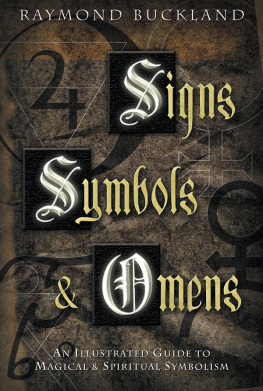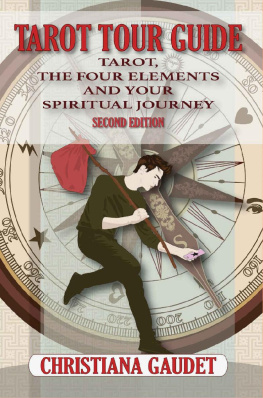
First published in 2010 by
Red Wheel/Weiser, LLC
With offices at:
500 Third Street, Suite 230
San Francisco, CA 94107
www.redwheelweiser.com
Copyright 2010 by Raymond Buckland.
All rights reserved. No part of this publication may be reproduced or transmitted in any form or by any means, electronic or mechanical, including photocopying, recording, or by any information storage and retrieval system, without permission in writing from Red Wheel/Weiser, LLC. Reviewers may quote brief passages.
Parts of the present work appeared in Secrets of Gypsy Fortunetelling (1988), Secrets of Gypsy Love Magick (1997), and Gypsy Witchcraft & Magic (1998). All Raymond Buckland.
ISBN: 978-1-57863-467-5
Library of Congress Cataloging-in-Publication Data is available on request.
Cover and text design by Dutton & Sherman Design.
Typeset in Adobe Garamond text and Poor Richard display.
Cover illustrations Dover Publications.
Author photo Gregory C. Ford.
Printed in the United States of America
TS
10 9 8 7 6 5 4 3 2 1
 The paper contains a minimum of 30% post-consumer-waste material.
The paper contains a minimum of 30% post-consumer-waste material.
www.redwheelweiser.com
www.redwheelweiser.com/newsletter
CONTENTS
Publisher's Note: Some remedies described here involve substances or methods used by the traveling people that may not be safely used in general. Please remember that this is not a medical book, but a report of cultural or historical practices.
ACKNOWLEDGMENTS
For Tara
and to my pral Pete Ingram.
With many thanks for the excellence of this product by Red Wheel/Weiser. In particular thanks to Amber Guetebier, Susie Pitzen, Rachel Leach, Jan Johnson, and Hilary Smith. It has been a joy to work with such a team.
PREFACE
The pendulum swings, in all things. In the folklore of the Romanithe Gypsiesthe pendulum has swung from the Romanticism of the nineteenth century to the harsh reality of the twenty-first. Gypsies today are often portrayed in near-poverty, living in cramped quarters and unhygienic environments. The emphasis seems to be on the lot of the Gypsiesoutcasts desperately needing to be absorbed into the mainstream. The intimation is that they should be absorbed, to the point of losing all identity.
As a poshrat myself (a half-blood Romani) and a lover of all that makes the Gypsy life so different from others, I would like to help the pendulum swing back a little to recapture some of the romance of the Gypsies. By this, I do not mean to deny the reality of the situation of today's Gypsiesnot necessarily, I emphasize, the Gypsy Problembut merely to focus on the more positive aspects of Gypsy life in an attempt to maintain a balance.
Whatever the state of the Gypsies today, theirs has, in the past, been a colorful lifestylea life spent in brightly painted vardos and benders, cooking over campfires, and moving about the countryside while scraping together an existence and living by their wits. I grew up in England in the mid 1930s. In my lifetime, I witnessed the gradual disappearance of the travelers in that country. Today, to my knowledge, there remains only one English Rom family that lives entirely by the old ways. There are others that still travel the roads, but they have adopted modern conveniences (including portable televisions and laptop computers). Most of these families have abandoned the old horsedrawn wagons for sleek, shiny motor homes.
As a distinct ethnic group, the Gypsies are indeed disappearing. Shortly after World War II, authorities in Britain forced them to place their children in schools and required that their children remain in one school for at least a full year. This, of course, precluded traveling the roads in the time-honored Gypsy tradition and forced them to take up permanent residence somewhere.
When they do attempt to travel, they are harassed by petty local officials and by laws seemingly designed to single them out. Racial discrimination against them is commonplace. As Pierre Derlon says in Secrets of the Gypsies:
Bureaucracy, the police state, national fanaticism, and a narrow shopkeeping mentality are getting the better of the last of the free men. There was a time when the only things that mattered to the gypsy were his own integrity, his tribe, the few square feet of earth on which he slept, and the roof of starlit sky which covered him. He had a harsh awakening.
Harsh indeed!
My intention in writing this book is to recapture some of the past before it is lost forever. If I seem to romanticize, I do so intentionally, so that thisaspect of the Gypsy tradition should not be lost. The Gypsies wereand still area colorful people, a race of individuals with their own pride and dignity. It would be a shame if they were assimilated to the point where their unique culture became extinct.
Pierre Derlon, Secrets of the Gypsies (New York: Ballantine, 1977), p. vii.
PART I: A HISTORY OF THIEVES
CHAPTER 1
TRAVELERS ON THE MOVE
That the Gypsy people originated in northern India is now firmly established. What is not established, and may never be, is what prompted their mass exodus from that area and the exact date that it started. In Gypsy Demons and Divinities, Elwood Trigg says:
It is sufficient to make the hypothesis that a thousand years after the appearance of the Aryan peoples in northern India, the area was continually invaded by successive armies of first the Greeks, then the Persians, Scythian and Kushites. In the later era, both the Huns and Mohammedans also invaded the area. It would seem that the incessant military and political turmoil which these successive invasions caused to northwestern India succeeded in dislodging certain tribes of people which have come to be known as gypsies. It is possible that these people, forced to become sedentary by their conquerors, moved west in hope of retaining their nomadic way of life.
Whatever the reason, at some time in the middle of the ninth or tenth century, large groups of Gypsies departed their homeland and moved westward. They passed through Pakistan, Afghanistan, and Persia, eventually reaching the Caspian Sea, north of the Persian Gulf. There, they split into at least two distinct groups. One went northward through Turkey and, by way of Byzantium, into Bulgaria. The other smaller band went southward, sweeping down through Jordan into Egypt.
By 1348, the nomads were in Serbia, with others heading north through Walachia and into Moldavia. By the turn of that century, they ranged from the Peloponnesus and Corfu in the south to Bosnia, Transylvania, Hungary, and Bohemia in the north. By the early 1400s, they had arrived in Central Europe: Rome, Barcelona, Orleans, Hildesheim, and Paris. The group from the south traveled through Egypt across the north of Africa and, crossing the Straits of Gibraltar, advanced through Spain to reach Granada. In 1417, there were travelers in Germany and, by 1430, they had reached England and Wales.
Because of their swarthy skin and colorful dress, some observers decided that these mysterious people must be descendants of the ancient Egyptians! They began to refer to them as the Egyptians, later shortened to the Gyptians and then to the Gypsies. They also became known, at different times and in different places, as Bohemians, Tartars, Moors, and even Saracens. In fact, they descended from a mixture of various northern Indian tribes: Jats, Nats, Dards, Sindhis, and Doms. The earliest record of the Romanifrom
Next page














 The paper contains a minimum of 30% post-consumer-waste material.
The paper contains a minimum of 30% post-consumer-waste material.